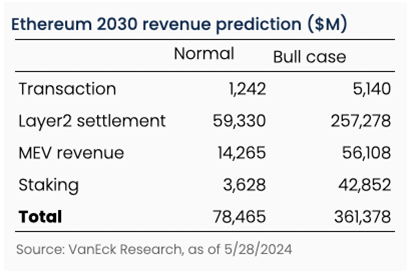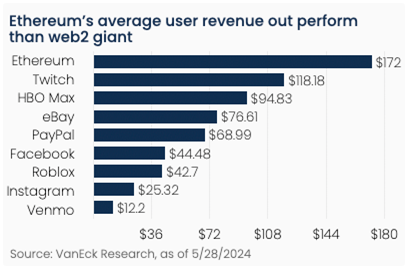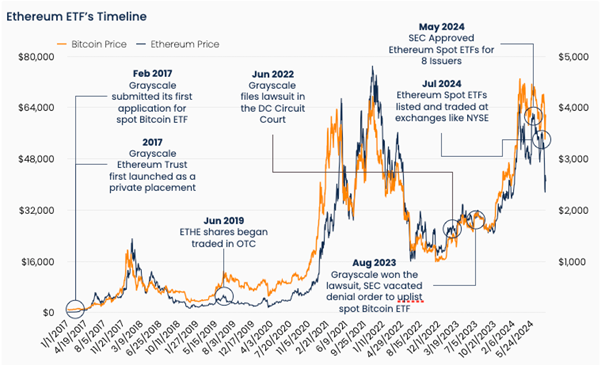As the second largest digital asset by market capitalization, Ethereum received approval for ETF issuance from the U.S. Securities and Exchange Commission (SEC) in May 2024, and was officially listed for trading on the New York Stock Exchange and other trading platforms in July. Since July 23, a total of nine Ethereum ETFs have been listed and started trading, including Grayscale’s ETHE and BlackRock’s ETHA.
This report is designed to help investors gain an in-depth understanding of Ethereum spot ETFs and will be divided into three parts:
- The first part reviews the development history of Bitcoin ETFs, explains in detail the similarities and differences between Ethereum and Bitcoin assets, and analyzes the income potential of Ethereum as the underlying asset.
- Part Two reviews the various developments in Ethereum ETFs, from the issuance of futures ETFs to Grayscale’s successful appeal, which prompted the issuance of crypto-asset ETFs.
- The third part introduces the market landscape of Ethereum ETFs and provides a detailed description of the fees and characteristics of different ETFs.
You can get details by downloading the full report in PDF format at the top or bottom of this article.
ETFs – From Bitcoin to Ethereum
Cryptocurrency ETFs refer to a type of digital asset fund that can be traded on compliant traditional financial exchanges (such as NYSE, NASDAQ). It allows investors to track and benefit from the price of cryptocurrencies such as Bitcoin without actually purchasing and holding the currency.
Generally, cryptocurrency ETFs are divided into two categories: spot and futures. They are both compliant products for traditional investors, allowing investors to invest in this new type of asset while leaving the actual purchase and custody work to professionals, clearing the way for them. technical obstacles. Currently, there are only two cryptocurrency ETFs in the U.S. market: Bitcoin and Ethereum.
Bitcoin ETFs Market Current Situation
There are currently more than 35 Bitcoin spot ETFs available for trading in the U.S. market, and as of July 10, 2024, their total assets under management reached US$50.29 billion. The average expense ratio is 1.08%. The largest Bitcoin ETF is iShares Bitcoin Trust IBIT, with assets of $18.28 billion. Over the past year, the best-performing Bitcoin ETF was GBTC, with a return of 164.42%.

Since the approval of Bitcoin ETFs, Grayscale's GBTC product has continued to decline due to high fees and various comprehensive factors, such as many early participants having made profits and leaving the market. As of August 2024, GBTC's accumulated net Outflows were US$19.045 billion. All other spot ETFs have seen steady inflows during the same period.
We have discussed the possible impact of Bitcoin ETFs on centralized exchanges, and also emphasized that Bitcoin ETFs are currently one of the few channels for traditional financial institutions to compliantly allocate digital assets. More views on Bitcoin ETFs For content, please refer to the "Bitcoin ETF Handbook 2024" .
The difference between Ethereum and Bitcoin
Similar to the Bitcoin network, Ethereum is also a decentralized blockchain network. In addition to the basic functions of transfers like the Bitcoin network, Ethereum can also run Code enables people to build applications and organizations.
The PoW proof-of-work consensus mechanism adopted by Bitcoin requires miners to consume a lot of electricity to maintain network security. However, the current Ethereum network adopts a more energy-saving PoS proof-of-stake consensus mechanism, which ensures the network security through staking. Decentralization and security.
The following table briefly summarizes the main on-chain data differences between Bitcoin and Ethereum, with the purpose of helping investors interested in Ethereum ETFs have a deeper understanding of the underlying assets.
 The potential of Ethereum
The potential of Ethereum
Assume that in all blockchain application scenarios, 70% of the market share occurs on Ethereum and its sidechains, and assume that Ethereum charges 5% – 10% fees from users of the application.
On this basis, adding Ethereum MEV profits, pledge income, network handling fees, etc., the future annual profit of Ethereum, according to VanEck's prediction, can reach 78.5 million US dollars, and if it is in a bull market scenario, it can exceed 360 million US dollars.  Although it is not yet possible to challenge the authority of the traditional financial system, its trend of diversified adoption is the focus of our belief that Ethereum has amazing future potential.
Although it is not yet possible to challenge the authority of the traditional financial system, its trend of diversified adoption is the focus of our belief that Ethereum has amazing future potential. 
The development history of Ethereum ETF
The first development of Ethereum in the SEC was in October 2023. The asset management company Valkyrie Funds included Ethereum ETH assets into its already issued Bitcoin futures ETF and renamed it Valkyrie Bitcoin and Ether Strategy ETF (BTF). This is the first time that Ethereum assets have been included in the ETF market.
The successful listing of the Ethereum spot ETF, in addition to external political factors, is largely due to asset management company Grayscale’s continued efforts in promoting crypto assets to obtain regulatory approval. After winning the lawsuit with the SEC in 2022, Grayscale successfully launched the first crypto-asset ETF—GBTC—in 2024. Four months later, the Ethereum spot ETF was quickly approved.

Source: coingecko, as of 2024/8/11
Ethereum Spot ETF Market Overview
As of August 12, 2024, there are 9 Ethereum spot ETFs in the U.S. market, with detailed information as shown in the table below.
The largest fund among them is ETHE issued by Grayscale introduced above, with a market value of more than 4.9 billion US dollars, accounting for 68% of the entire market. It was transformed from trust funds that could only be traded in the OTC market before.
 Download the full report as a PDF for detailed insights into each Ethereum ETF.
Download the full report as a PDF for detailed insights into each Ethereum ETF.
About LTP
LTP is the digital asset prime broker (Prime Broker) in the Asia-Pacific region, providing customers with key links between centralized digital asset exchanges (CEXes) and decentralized exchanges (DEXes). We provide comprehensive professional trading services to global institutional clients, which rely on the most advanced technology and are designed to ensure safety, speed, low cost and efficiency.
Our global reach, coupled with top-notch security measures, ensures our customers receive the best possible service. Our expertise is trusted by exchanges, market makers, hedge funds, family offices and funds of funds globally.
Official website: www.liquiditytech.com
LinkedIn: https://www.linkedin.com/company/liquiditytech/
X: https://x.com/ltp_primebroker







